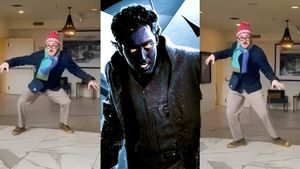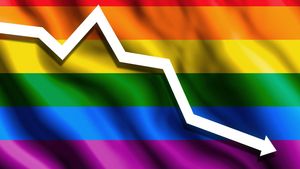It, probably the best film adaptation of a Stephen King book since The Shining, has come under fire from more than one critic for reducing what’s a Homeric poem length novel — clocking in at over 1,100 pages — into a two hour movie (the film is billed as "Chapter One" and takes lots of liberties).
Yet, watching the film brought back a tremendous wave of memories and sexual awakening that I experienced when reading the book over the course of a weekend in 1989 at 12-years-old.
I remember two things: a) I couldn’t put it down, and b) masturbating to a homoerotic group sex scene between the boys. Let's just say, I did that a lot this particular summer, and it awakened me to feelings for other boys I couldn’t quite articulate to myself at the time.
I was relieved that so many major entertainment sites were bringing up the scene’s omission up at all. The scene involves the prepubescent teen heroes — The Losers’ Club — all having sex with each other in the sewers as a way to connect each other and keep them together throughout the events of the book. It was left out of both adaptations of King’s story for obvious reasons, though his original intentions seemed to be less about children having sex, and more about the meaning behind it in that scenario.
Screenwriter Gary Dauberman says of the scene, “That’s going to be difficult for anybody to get across in a movie, no matter how you try to spin it.” But King himself tried to explain it in a 2013 social media post that confirmed his original intentions and also showed some regrets "Times have changed since I wrote that scene and there is now more sensitivity to those issues,” he said simply.
King felt "the orgy scene," as it’s came to be known, was important for the characters: “The sexual act connected childhood and adulthood. It’s another version of the glass tunnel that connects the children’s library and the adult library.”
I loved the movie because it captures the adolescent hormonal bravery and naiveté that often went hand in hand when you’re that age. It’s also worth noting that many critics who recognized the glaring omission of the orgy scene go on to say that as with many things American, it “suggests… that we are perfectly fine with violence against women and children — but sexuality” and the suggestion of sexual agency “is still a no-no.”
Entertainment Weekly noted, “the original scene has been the subject of debate ever since the book’s release in 1986, it has proven an interesting experiment in adaptation. Throughout King’s career, he has pushed boundaries, especially in his depiction of adolescent sexuality, and the fact that the two produced adaptations of It have avoided the book’s most challenging scene entirely is telling about the respective mediums and what happens when words on the page become light and sound.” — I tend to agree.
Interestingly, because of director Andrés Muschietti decision to move the protagonists’ younger years and the the action to the '80s — as opposed to the '50s — we get hypochondriacally plagued Eddie Kasprack’s character talking about AIDS being transmitted to his mother’s friend on the subway by “touching the pole,” and the ubiquitous use of the word f****t. It's uttered frequently by über bully Henry Bowers in ways that brought back the terror and pernicious fear the word once inspired in me as an adolescent.
The constant talk about the raw sewage filled 'grey waters' of the underground tunnels where the boys pursue the titular monster at the heart of the book couldn't help but bring to mind the Hepatitis A outbreak in San Diego's streets this past week.
It will certainly linger as a lasting piece of ‘80s queer sensibility just for the "orgy scene," but the film, in tandem with the book, takes the Lovecraft-ian tale of terror to new levels of relevance.

















































































